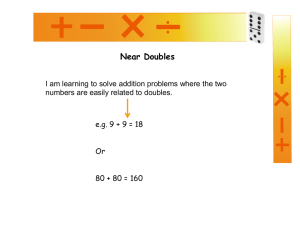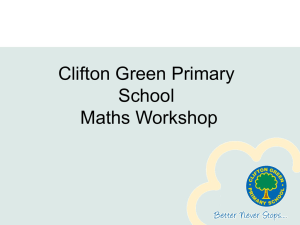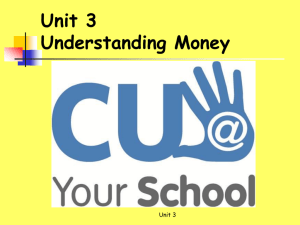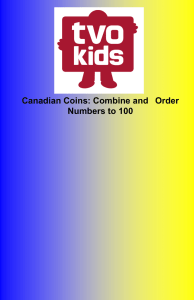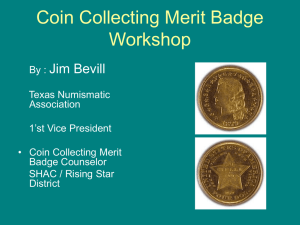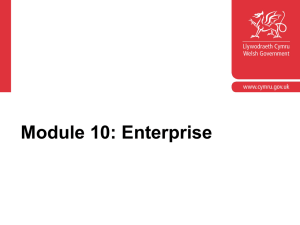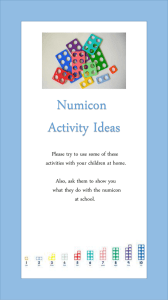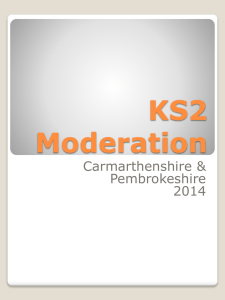Manage money - Learning Wales
advertisement
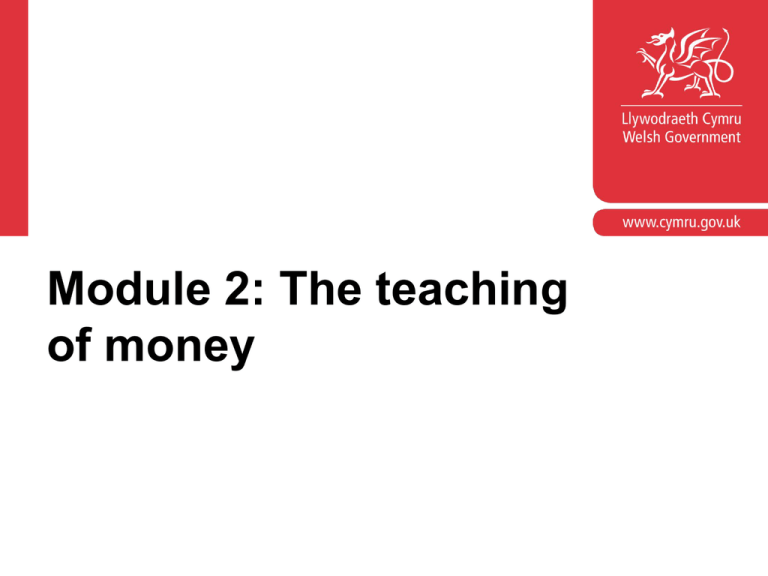
Module 2: The teaching of money Module objectives • Provide effective strategies and resources to support learners’ knowledge and understanding of money and its functions and uses. • Identify activities that can be used in the classroom to develop learners’ skills as outlined in the ‘Manage money’ element of the numeracy component of the National Literacy and Numeracy Framework (LNF). Curriculum opportunities to deliver financial education Specific elements of financial education have been included in the following Welsh Government documents. • Foundation Phase: Framework for Children’s Learning for 3 to 7-year-olds in Wales • National Literacy and Numeracy Framework (LNF) • Mathematics in the National Curriculum for Wales • Personal and social education framework for 7 to 19-year-olds in Wales • Careers and the world of work: a framework for 11 to 19-year-olds in Wales The National Literacy and Numeracy Framework (LNF) The National Literacy and Numeracy Framework (LNF) focuses on four strands of numeracy: • • • • Strand 1: Developing numerical reasoning Strand 2: Using number skills Strand 3: Using measuring skills Strand 4: Using data skills. Numeracy component of the LNF Strand: Using number skills Elements: • Use number facts and relationships • Fractions, decimals, percentages and ratio • Calculate using mental and written methods • Estimate and check • Manage money LNF learner outcomes The following tables show the learner outcomes as specified in the numeracy component of the LNF. The focus here is on the ‘Manage money’ element. Statements in bold type are the learner outcomes covered in this module. LNF learner outcomes Manage money Learners are able to: Reception • use 1p, 2p, 5p and 10p coins to pay for items. Year 1 • use different combinations of money to pay for items up to 20p • find totals and give change from 10p. Year 2 • use different combinations of money to pay for items up to £1 • find totals and give change from multiples of 10p. learning.wales.gov.uk/resources/nlnf/?skip=1&lang=en Manage money Learners are able to: Year 3 • use different combinations of money to pay for items up to £2 and calculate the change • order and compare items up to £10 • record money spent and saved. Year 4 • use money to pay for items up to £10 and calculate the change • order and compare items up to £100 • add and subtract totals less than £10 using correct notation, e.g. £6.85 – £2.76 • manage money, compare costs from different retailers and determine what can be bought within a given budget. Year 5 • order and compare the cost of items up to £1 000 • add and subtract totals less than £100 using correct notation, e.g. £28.18 + £33.45 • plan and track money and savings by keeping accurate records • realise that budgeting is important. Year 6 • use the terms profit and loss in buying and selling activities and make calculations for this • understand the advantages and disadvantages of using bank accounts • make comparisons between prices and understand which is best value for money. Routes to learning in the LNF Manage money Learners are able to: A steps • give a coin in exchange for an item after observing others do so in role play shop (may have no notion of coin’s value but will engage in the social interaction). B steps • point to choice of item from two or three in role play shop then give coin(s) in exchange • find coins from a limited collection which are the same as ones shown by the adult. C steps • give money in exchange for an item in a real shop when coins and choice are prepared in advance • sort coins according to one attribute, e.g. colour, size or shape. If applicable for your learners, are there opportunities in your teaching for the above skills to be developed? Add your ideas to the ‘Manage money planner’ available as a download in this module. Manage money planner Ongoing task: Think about the opportunities in your teaching to develop the following skills and add them to column 3 of the ‘Manage money planner’ (see Resource 1). Manage money planner Manage money planner Teaching money Starter activity: Cheap or expensive? Ask the first person in the group to say something that is cheap, the next person says something that is expensive and so on. Ask: • Which is the cheapest item someone said? • Can you think of anything cheaper? • Which is the most expensive item? • Can you think of anything more expensive? Role play A role play area involving money gives learners opportunities to develop an awareness of the use of money and its value. Use real money where possible. Ideas • Consider having two role play areas: one home and one money related. • The children at ‘home’ can discuss their needs, plan purchases, write a list, decide how to pay, count money, check bank balances, etc. before shopping. • In the commercial setting children can count, order, categorise, arrange displays, decide and write prices, carry out transactions, write receipts, etc. Role play ideas involving money • • • • • • • • • Pirate island. Post Office. Café/restaurant. Garden centre. Vet. Santa’s grotto. Theatre. Bank. Shop – there are many types to choose from! A selection of role play shops recommended by teachers in Wales • • • • • • DIY/builders yard Pet shop Local shop Toy shop Shoe shop Fruit and vegetable shop • Pound shop • Castle shop • Prince and princess shop • Museum shop • Hat shop • Fancy dress shop • Bookshop Role play talk • • • • • • • • • • How do you know what things cost? How does the shopkeeper know what prices to put on things? What do you need to take when you go shopping? How do you know how much you will have to pay altogether? What money will you give the shopkeeper? Will you get any change? How much? Where will you get money from? What will you do if you do not have enough money? What does a credit card do? Does anyone in your family write a shopping list before they go out? • Do they buy anything that is not on the list? • Does it matter if there are spelling mistakes on the list? • Why don’t you put things straight in your bag when you are shopping? (Adapted from Money Counts, Financial Services Authority) Role play skills Train a group of children to use the role-play equipment properly. These ‘managers’ can then train the other children. They may need to: • use the till correctly • decide prices • write labels clearly • record orders • write a receipt • keep a log of items sold • give change. Idea: Have ‘cashiers/accountants’ to count the money at the end of each day. Have a laminated checklist ready – How many of each coin? How much money for each type of coin? How much money altogether? Prices • Negotiate prices with learners. • They will usually choose from a range they are comfortable with. You can alter as they make progress, looking at the appropriate learner outcomes in the numeracy component of the LNF. • Ask learners to research prices (homework/internet). • It should naturally raise the issue of price differences across a variety of shops. Points to consider Some learners are surprisingly competent with money, some are surprisingly not. • The life experiences of the learner make a difference in their ability to use money. • Whether or not they receive pocket money, the distance they live from shops and an increasingly cashless society are some of the reasons why learners may be more or less able to use money confidently. Assess to find a starting point Assessment ideas: • Start with a map of what the class/individual learners already know about money. • Once you have found a starting point for learners, use the ‘Manage money’ element of the numeracy component of the LNF to plan progressive lessons. Activities and resources to support the learner outcomes in the ‘Manage money’ element of the numeracy component of the LNF Use 1p, 2p, 5p and 10p coins to pay for items (‘Manage money’ element of the numeracy component of the LNF: Reception) Useful resources: real coins, oversized coins, tills. Activity ideas: • Sort coins according to shape/colour/amount. • Sort real money onto oversized coins/into a till. • Find coins in sand/water/soil. One child collects 5p, another collects 2p, etc. Ask ‘How many coins? How much money?’. • Give each child a set of coins. Ask them to ‘Find a coin like this/a 5p coin/the coin worth the least amount of money/coins to total 8p/your favourite coin’ etc. • Snap/bingo/pairs/matching games using coins and prices. • Label a large dice with coins/prices. Children roll the dice; can they find the corresponding coin from a set of real money. Note: Coin recognition is harder for some learners now since same value coins do not always have the same picture and the value is not always written on the coin. Use different combinations of money to pay for items up to 20p/£1/£2/£10 (‘Manage money’ element of the numeracy component of the LNF: Years 1, 2, 3, 4) Useful resources: real coins, multi-sensory resources (e.g. Numicon), role play area with a money theme, counting stick labelled relating to money (e.g. 5p,10p,15p, etc.), money place value cards (see Resource 2), a real coin placed on the corresponding numeral on classroom numberlines, Money Flik-Flaks https://hwb.wales.gov.uk/searchsite/Results.aspx?k=flik%20flaks bead strings, bead bar. Activity ideas: • Match each coin to its value in pennies using multi-sensory resources, e.g. Numicon. • Give the children a set of coins. Can they order the coins from least amount of money to highest amount of money? And highest amount to least amount? • How many ways can you make --p? • I’ve got 4 coins in my purse, how much money might I have? • I’ve got --p in my purse, which coins could I have? • Buy items in the role play area, how much altogether? • Have occasional ‘rules’ with activities in the role play area, e.g. shoppers can only use 1p and 2p coins, use the exact money, use silver coins, etc. • Coin Challenge Games. Snapshot of Coin Challenge game https://hwb.wales.gov.uk/cms/hwbcontent/Shared%20Documents/vtc/200910/maths/financial-literacy/coin-challenge.html Add and subtract totals less than £10/£100 using correct notation (‘Manage money’ element of the numeracy component of the LNF: Years 4 and 5) Useful resources: multisensory resources (e.g. Numicon), real money, bead strings, bead bar, number lines, money place value cards (see Resource 2), dice labelled with coins/notes/amounts of money/instructions. Activity ideas: • Shopping stories (see Activity 1). • Coins in the tin (see Activity 2). • Blank dice games (see Activity 3). • Bingo (see Activity 4). Role-play activities: • Buy two or more items: how much altogether? • Start with a given amount of money: how much is left after buying items? • You have £5 to spend: what will you buy? • All items are 20p more or 5p less today: can you write the new price labels? Activity 1: Shopping stories Make up stories about shopping. At each stage of the story learners show the amount of money on their money place value cards. For example: I went shopping with £4.50. On the way to the shops I went to see my auntie, she gave me 50p. How much do I have now? I bought a book in the 99p shop, how much do I have left? I bought a bottle of water for 75p, how much do I have left? When I got home I put half of my money in my savings box. How much do I have left in my purse? (Resource 2 – Money place value cards) Activity 2: Coins in the tin Drop coins into a tin. Learners watch, listen and then show the total on their money place value cards (or write totals on whiteboards). Idea: Use 3 tins labelled ‘£1’, ‘10p’ and ‘1p’ and drop relevant coins into the tins to reinforce place value. Idea: Use 2p, 5p or 10p coins when teaching counting in steps of 2, 5 or 10. Idea: Split the class into groups, each group counts in steps of a different coin. Count forwards and backwards. (Resource 2 – Money place value cards) Activity 3: Blank dice ideas Idea: Label dice with coins/prices. • Roll the dice 3 times each – who has the most amount of money? • Add up the coins until you reach a set total. • Subtract coins from a start total. How much is left after each throw? Who has the least/most amount of money at the end? Idea: Label dice with instructions. For example, double, halve, add 10p, subtract 25p, etc., from a start amount. Who has the most money after 6 throws each? Activity 4: ‘5p off sale’ bingo Original shop prices: 10p 20p 30p 40p 50p 60p 70p 80p 90p £1 Special offer – everything is 5p off today! Choose any 5 of today’s new prices to write on your bingo board. When the caller calls the original price, you can cross off the new price (e.g. if the caller says 70p, you may cross off 65p). Give change from 10p/multiples of 10p/£2/£10 (‘Manage money’ element of the numeracy component of the LNF: Years 1, 2, 3, 4) Useful resources: real money, multisensory resources (e.g. Numicon), bead strings (10, 20 or 100 as appropriate), bead bar, number lines, counting stick. Activity ideas: The children will need lots of practice at counting on/back in steps of coins and finding the difference. • Coins In the Tin (see Activity 2) • ‘Let’s go shopping’ (see Manage money activity sheet: Let’s go shopping) • Flik-Flaks (https://hwb.wales.gov.uk/SearchSite/Results.aspx?k=flik%20flaks) Give change from 10p/multiples of 10p/£2/£10 (‘Manage money’ element of the numeracy component of the LNF: Years 1, 2, 3, 4) Useful resources: real money, multisensory resources (e.g. Numicon), bead strings (10, 20 or 100 as appropriate), bead bar, number lines, counting stick. Role-play ideas: • The ‘shopper’ can only use 10p coins/£1 coins, etc., with items being priced lower so that change will be needed. • You can differentiate by giving appropriate coins to different ‘shoppers’. • Set up a task for learners, then observe. • Flik-Flaks (https://hwb.wales.gov.uk/searchsite/Results.aspx?k=flik%20flaks) Idea: Consider placing a basket of resources next to the till to support the ‘shopkeeper’ when giving change (e.g. whiteboard/pen for jottings, bead string, number line, money place value cards, Numicon). Order and compare items up to £10/£100/£1 000 (‘Manage money’ element of the numeracy component of the LNF: Years 3, 4, 5) Useful resources: real money, multisensory resources (e.g. Numicon), bead strings, bead bar, counting stick labelled in money values (e.g. £10, £20, £30, up to £100), priced items, price tags. Activity ideas: • Compare two (or more) prices. Which is least/most expensive? (Use Numicon/real money/bead bar/number line if children cannot do this mentally). • Place priced items in order from least to most expensive (or most to least expensive). • Place price tags correctly on labelled counting stick/number line/bead bar. • Compare different brands of the same product to help learners become ‘smart consumers’. Let’s go shopping Resource links/downloads Resource 1 – Manage money planner Resource 2 – Money value place cards Additional resource – Flik-Flaks https://hwb.wales.gov.uk/searchsite/Results.aspx? k=flik%20flaks Useful websites • Hwb – www.hwb.wales.gov.uk • www.pfeg.org pfeg (Personal Finance Education Group) is an independent charity providing a wealth of resources to support financial education in schools. – For assessment ideas see pfeg’s ‘Learning About Money – Primary Assessment Ideas’. – See pfeg’s ‘Primary Toolkit’ for a variety of teaching activities and resources. • www.nationwideeducation.co.uk Finance skills: games, storybooks, factsheets* and worksheets* for learners aged 4 to 18+ (printable resources and online games). * Welsh versions available. • www.teachers.rbs-pocketmoney.co.uk/index.html A selection of interactive games, lesson plans and activity sheets to reinforce classroom teaching. Useful websites • www.bankofengland.co.uk/education/Pages/poundsandpence/default.aspx ‘Pounds and Pence’ is intended for teachers of learners aged 9–11. It provides a range of information and activity cards that will encourage learners to think about money and prices. • www.barclaysmoneyskills.com/en/Information/Resource-Centre/Schoolchildren.aspx See ‘Barclays Money Skills Resource Packs Key Stages 1 and 2’ – the resources have been designed to support the delivery of fun, interactive sessions on basic money management topics. • www.moneyville.co.uk Moneyville is an educational website that was designed to enable school children aged 5 to 9 years old to learn more about money in a fun and interactive environment. • www.valuesmoneyandme.com The interactive resources help children to explore the world of money within the context of personal and ethical values. Children will begin to appreciate the sometimes complex, emotional and moral dilemmas that we all face in relation to money.
